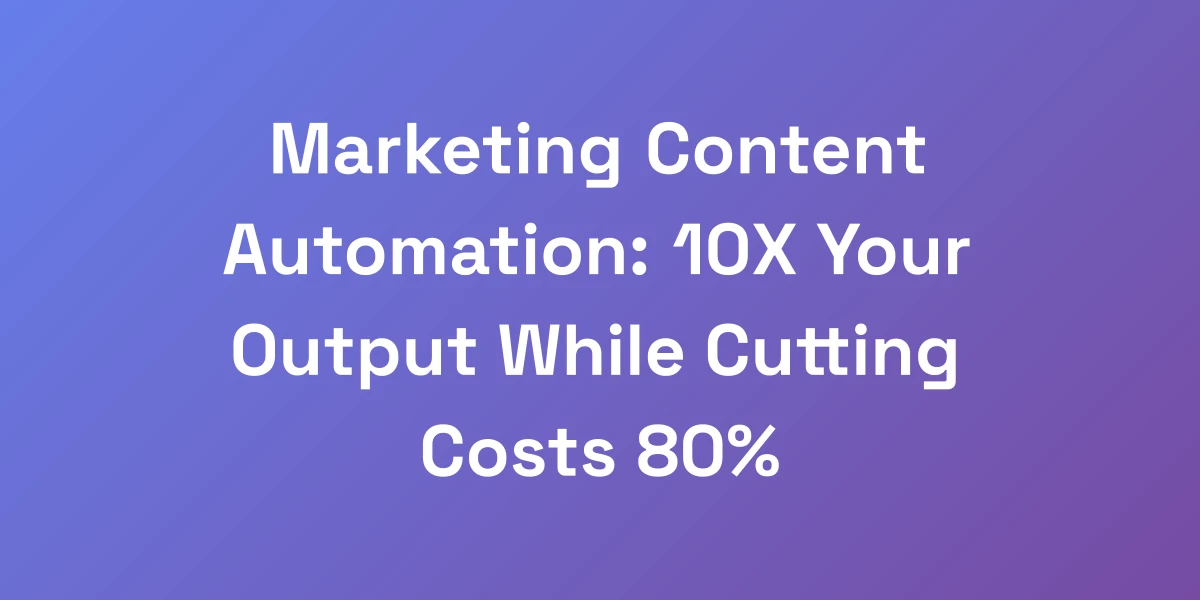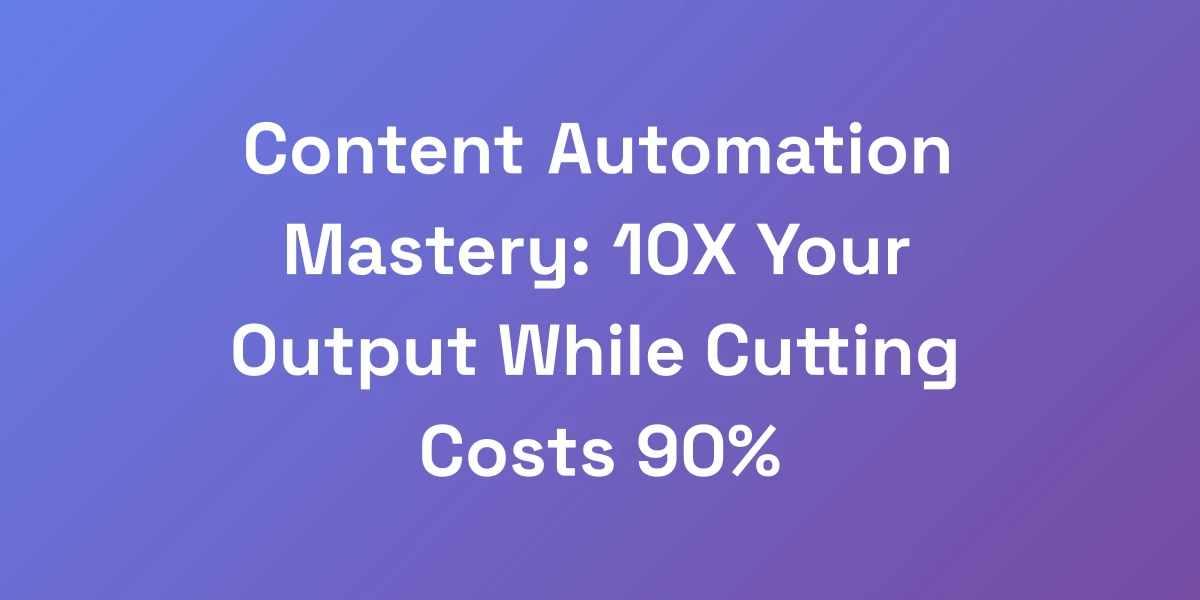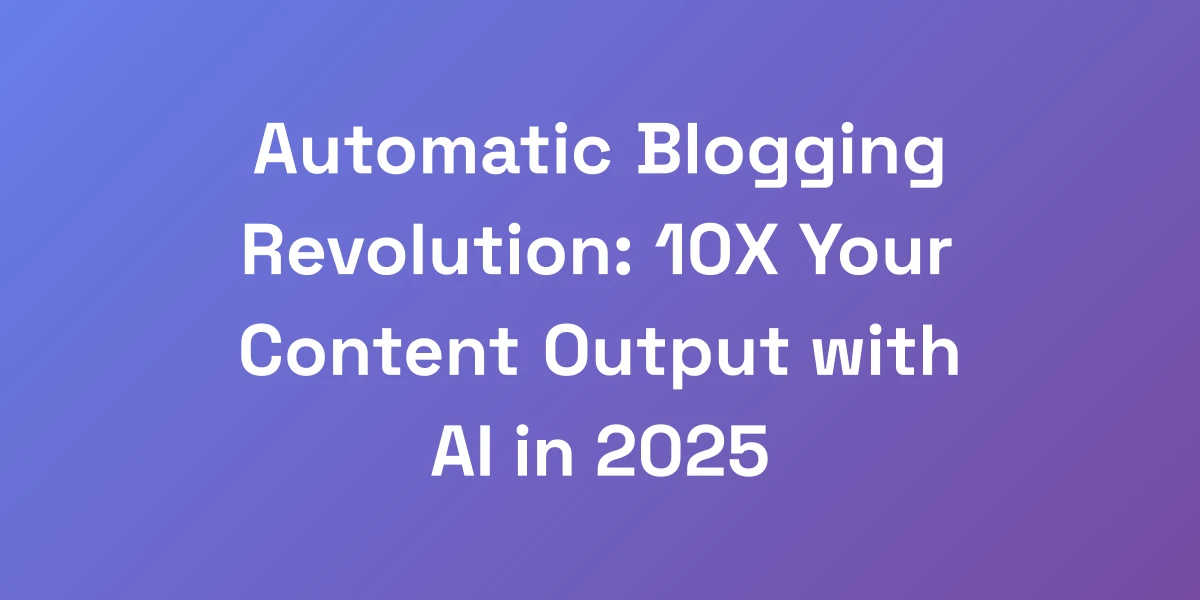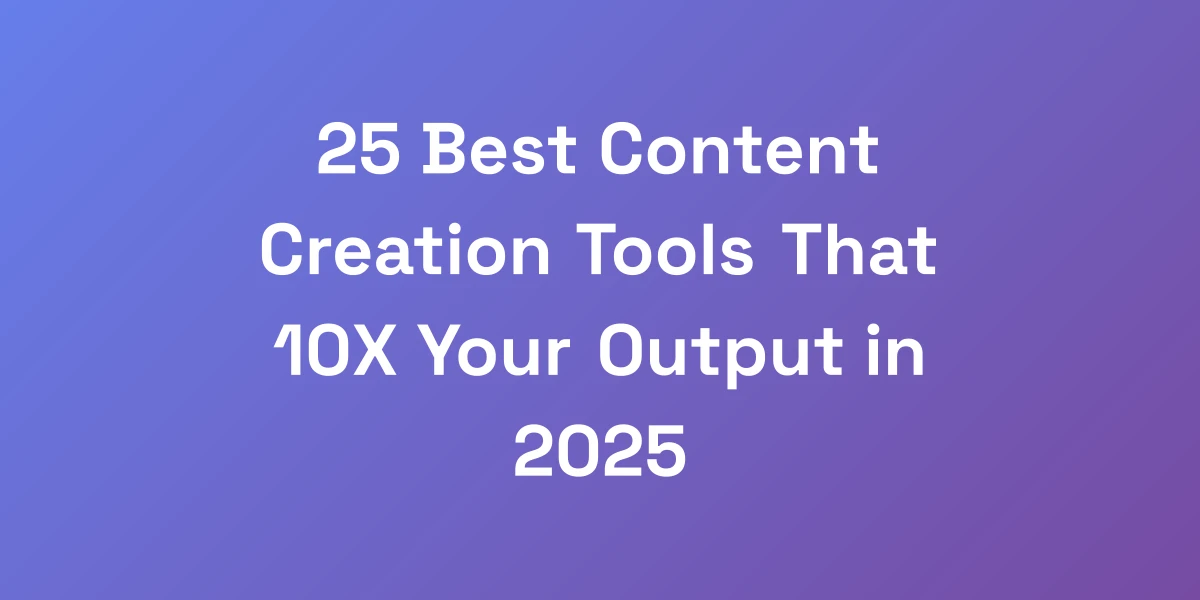
Content Scaling: 7-Figure Framework to 10X Your Output Fast
Mar 30, 2025 | By [email protected]
The Million-Dollar Content Scaling Mindset
Listen up. Most content creators are playing checkers while the top 1% are playing chess.
The difference? Strategic scaling. We’ve built multiple 8-figure businesses by treating content like a machine, not an art project, as detailed in this inside look at 10X-ing my business.
Here’s the truth: You don’t need more time or resources to scale—you need a completely different operating system.
What we’re about to share isn’t just theory; it’s the exact framework we’ve used to generate millions in revenue through scaled content operations.
Why Traditional Content Creation Is Killing Your Growth
Traditional content creation often relies on sporadic bursts of creativity and inconsistent output. This approach limits your ability to build momentum and maintain audience engagement. How many times have you poured hours into a single blog post, only to see minimal returns?
Relying solely on creativity without a strategic framework means you’re leaving growth to chance. It’s like driving without a map—you might eventually reach your destination, but the journey will be inefficient and uncertain.
Instead of treating content as a one-off project, we must integrate it into a scalable system that consistently delivers value and drives revenue.
The 80/20 Principle of Content Scaling
The 80/20 Principle states that 80% of your results come from 20% of your efforts. Applied to content scaling, this means identifying the content strategies that yield the highest ROI and focusing your resources there.
- Identify High-Performing Content: Analyze which pieces of content generate the most traffic, engagement, and conversions.
- Replicate Success: Create more content in the same vein, leveraging the elements that made the original successful.
- Optimize Resources: Allocate your time and budget to strategies that offer the highest returns, eliminating low-impact activities.
By focusing on the strategies that drive the most value, you can exponentially increase your content’s impact without exponentially increasing your workload.
Shifting from Creator to Content CEO
To truly scale, you need to adopt the mindset of a CEO overseeing content operations, rather than a lone creator. This shift in perspective allows you to view content as a strategic asset that drives business growth.
- Strategic Planning: Develop a comprehensive content strategy aligned with your business goals.
- Team Building: Assemble a team of skilled professionals to handle different aspects of content creation and distribution.
- Performance Tracking: Implement metrics to monitor the effectiveness of your content and make data-driven decisions.
By taking on the role of Content CEO, you can systematize your content processes, ensuring consistency, quality, and scalability.
Understanding the ROI-First Approach
Every piece of content should be created with return on investment (ROI) in mind. This means evaluating the potential value of content before creation and measuring its performance afterward.
- Set Clear Objectives: Define what success looks like for each content piece—be it lead generation, brand awareness, or sales.
- Measure Impact: Use analytics to track how each piece of content contributes to your objectives.
- Optimize Continuously: Adjust your strategies based on performance data to maximize ROI.
By prioritizing ROI, you ensure that every piece of content serves a strategic purpose and contributes to your overall business goals.
Building Your Content Scaling Flywheel
A flywheel is a self-sustaining loop that builds momentum over time. In content scaling, it involves creating a cycle where each piece of content feeds into the next, generating continuous growth.
- Content Creation: Produce high-quality content that attracts and engages your audience.
- Audience Engagement: Foster interactions through comments, shares, and feedback.
- Data Analysis: Gather insights from audience behavior and content performance.
- Optimization: Refine your content strategy based on data to improve future content.
This cyclical process ensures that your content operations become more efficient and impactful over time, driving exponential growth.
Engineering Your Content Production Machine
Stop thinking like a blogger and start thinking like a factory owner. Your content operation needs systems, not inspiration.
We’ve seen businesses go from 2 posts a month to 20 without hiring a single new writer. The secret? Engineered workflows that eliminate decision fatigue and maximize output by leveraging content marketing automation tools.
We’re talking about building a predictable content machine that runs whether you’re sleeping or on vacation.
Creating Your Content Production SOPs
Standard Operating Procedures (SOPs) are the backbone of a scalable content operation. They provide content SOP examples for every aspect of content creation, ensuring consistency and efficiency.
- Idea Generation: Establish a process for brainstorming and selecting content topics based on audience needs and SEO potential.
- Content Creation: Define the roles and responsibilities of your team members, from writers to editors.
- Publication: Create a timeline for drafting, reviewing, and publishing content.
By documenting these processes, you create a repeatable framework that allows your team to produce high-quality content consistently.
The Perfect Content Brief Template
A well-crafted content brief is essential for guiding your team and maintaining clarity throughout the content creation process.
- Title and Objective: Clearly state the purpose and expected outcomes of the content piece.
- Target Audience: Define who the content is for, detailing demographics and preferences.
- Key Points and Structure: Outline the main topics, subtopics, and the desired format of the content.
- SEO Guidelines: Provide target keywords, meta descriptions, and other SEO requirements.
- Resources and References: Include any necessary materials, links, or data that should be incorporated.
Using a standardized brief ensures that every piece of content aligns with your strategy and meets quality standards.
Building Your Content Assembly Line
Think of your content team as an assembly line, where each member plays a specific role in the content creation process.
- Writers: Responsible for producing the initial drafts based on the content briefs.
- Editors: Ensure the content is polished, accurate, and aligns with brand voice.
- SEO Specialists: Optimize content for search engines, integrating keywords and improving readability.
- Designers: Create visual elements that complement and enhance the written content.
- Publishers: Schedule and distribute the content across relevant platforms.
By clearly defining roles and streamlining the workflow, you can increase efficiency and output without compromising quality.
Quality Control Checkpoints
Maintaining high quality is crucial as you scale your content operations. Implementing multiple quality control checkpoints ensures that every piece meets your standards.
- Initial Review: Writers review their drafts before submission to catch basic errors.
- Editorial Review: Editors provide feedback and make necessary adjustments to improve clarity and engagement.
- SEO Audit: Auto SEO tools ensure that the content is optimized for search engines.
- Final Approval: A final review before publication to ensure all elements are cohesive and polished.
These checkpoints help catch errors early and maintain consistency across all content pieces, reinforcing your brand’s credibility and authority.
Automation and AI Integration Points
Leveraging automation and AI tools can significantly enhance your content production efficiency.
- Content Scheduling: Use tools like Eclincher and HubSpot to automate publishing schedules.
- AI Writing Assistants: Tools like ChatGPT and Writesonic can help generate content drafts quickly through AI automated content creation.
- SEO Optimization: Implement SEO optimization automation tools to suggest keywords and optimize on-page SEO elements.
- Analytics and Reporting: Automate data collection and analysis to monitor content performance effortlessly.
Integrating these technologies reduces manual workload, speeds up the content creation process, and ensures that your team can focus on strategic tasks, such as autoblogging.
Scaling Without Sacrificing Brand Voice
As you scale, maintaining a consistent brand voice becomes challenging but crucial for brand recognition and trust.
- Voice Guidelines: Document your brand’s voice and tone to guide all content creators.
- Training: Regularly train your team on brand guidelines to ensure consistency.
- Review Process: Implement thorough reviews to check for voice consistency before publishing.
- Centralized Resources: Create a style guide and centralized repository of brand assets for easy reference.
By prioritizing brand voice in your scaling strategy, you ensure that your content remains authentic and resonates with your audience.
The High-Leverage Content Multiplication Strategy
Here’s where most people mess up: they create one piece of content and move on. That’s amateur hour.
Every piece of content should spawn at least 10 more pieces. We’ve generated 7-figures from single blog posts by mastering content multiplication.
The key is understanding how to extract maximum value from every piece of content you create, then systematically turning one asset into an entire content ecosystem.
The 1:10 Content Multiplication Framework
Our 1:10 framework ensures that each primary content piece can generate multiple derivative assets across various platforms.
- Main Content: Start with a comprehensive blog post or article.
- Social Media Posts: Extract quotes, statistics, and key points to create engaging social media content.
- Videos: Turn the content into video scripts for platforms like YouTube or Instagram.
- Infographics: Visualize data and key insights in infographic format for easy sharing.
- Email Newsletters: Incorporate segments of the content into email marketing campaigns.
- Webinars: Expand on the topic with a live or recorded webinar for deeper engagement.
- Podcasts: Discuss the content in a podcast episode, inviting relevant guests for added value.
- E-books or Guides: Compile multiple related pieces into a downloadable resource.
- SEO Optimization: Repurpose content for SEO by targeting different keywords and optimizing for search engines.
- Collaborations: Use the content as a basis for collaborating with influencers or partners.
By implementing this framework, you maximize the reach and impact of each content piece, ensuring that no valuable insight goes untapped.
Cross-Platform Content Adaptation
To fully leverage your content, it’s essential to adapt it for different platforms and audiences.
- Blog to Social Media: Break down blog posts into bite-sized social media updates.
- Articles to Videos: Create visual content that complements your written material.
- Webinars to Podcasts: Convert webinar recordings into podcast episodes.
- Infographics to Slides: Use infographic data to create engaging slide decks for presentations.
This cross-platform strategy ensures that your content reaches a wider audience and caters to different consumption preferences.
AI-Powered Content Repurposing
AI tools can streamline the repurposing process, making it easier to transform content across formats.
- Automated Summaries: Use AI to generate concise summaries of long-form content for quick consumption.
- Content Translation: Expand your reach by translating content into different languages with AI assistance.
- Visual Content Creation: Leverage AI design tools to create visuals based on your content automatically.
Integrating AI in content repurposing saves time and ensures consistency across all formats, allowing for rapid scaling.
Creating Content Clusters for SEO Dominance
Content clusters involve creating a network of related content pieces around a central theme or pillar content.
- Pillar Content: Develop a comprehensive piece that serves as the foundation for the cluster.
- Cluster Content: Create related articles or posts that delve into specific aspects of the pillar topic.
- Internal Linking: Strategically link cluster content back to the pillar content to boost SEO.
- Keyword Optimization: Target related keywords within cluster content to capture diverse search queries.
This strategy enhances your site’s authority on specific topics, improving search engine rankings and driving more organic traffic.
Maximizing Content Shelf Life
Ensuring your content remains relevant and valuable over time is key to sustained success.
- Regular Updates: Periodically review and update content to reflect the latest information and trends.
- Evergreen Content: Focus on creating content that remains relevant regardless of time.
- Content Refreshing: Republish or repromote older content to introduce it to new audiences.
By maximizing the shelf life of your content, you extend its value and continue to reap benefits long after its initial publication.
Automated Distribution Systems
Automating the distribution of your content ensures it reaches your audience efficiently and consistently.
- Social Media Scheduling: Use tools like Eclincher to schedule and automate social media posts.
- Email Automation: Integrate content into automated email campaigns for regular engagement.
- Content Syndication: Partner with other platforms to distribute your content widely without manual effort.
Automation frees up time and ensures your content is consistently delivered to your audience, enhancing engagement and reach.
Scaling Content Teams Without Scaling Costs
Want to know why most content scaling efforts fail? They throw money at the problem instead of solving it.
We’ve built content teams that produce 100+ pieces monthly while keeping costs lower than competitors producing 10 pieces.
It’s about strategic leverage, not headcount. The framework we’re about to share has saved our clients millions in unnecessary hiring while 10X-ing their content output.
The Lean Content Team Structure
Scaling efficiently requires a lean team structure focused on high-impact roles.
- Content Manager: Oversees the entire content strategy and ensures alignment with business goals.
- Writers: Produce high-quality content pieces tailored to different platforms.
- Editors: Refine content for clarity, coherence, and adherence to brand voice.
- SEO Specialist: Optimizes content for search engines to drive organic traffic.
- Designer: Creates visual assets that complement written content.
- Social Media Manager: Manages content distribution across social platforms.
By focusing on essential roles, you maintain high productivity without inflating costs.
Training and Onboarding Systems
Effective training and onboarding systems ensure your team is well-equipped to handle content scaling.
- Comprehensive Training Programs: Provide detailed training on content creation, SEO, and brand guidelines.
- Onboarding Checklists: Streamline the onboarding process with clear steps and resources for new team members.
- Continuous Learning: Encourage ongoing education and skill development to keep the team updated with industry trends.
Investing in training ensures your team remains efficient and capable of producing high-quality content consistently.
Performance Metrics and KPIs
Tracking performance is crucial for managing and optimizing your content team.
- Content Output: Measure the number of content pieces produced within a specific timeframe.
- Engagement Rates: Monitor likes, shares, comments, and other engagement metrics.
- Conversion Rates: Track how content contributes to lead generation and sales.
- SEO Performance: Analyze keyword rankings and organic traffic growth.
By setting clear KPIs, you can assess team performance, identify areas for improvement, and ensure alignment with business objectives.
Outsourcing vs. In-House Balance
Striking the right balance between outsourcing and in-house production can optimize costs and efficiency.
- Core Content: Keep strategic and high-impact content creation in-house to maintain control and consistency.
- Supplementary Content: Outsource tasks like graphic design or specialized writing to freelancers or agencies.
- Cost Efficiency: Outsourcing allows access to specialized skills without the overhead costs of full-time employees.
By leveraging external resources for non-core tasks, you can focus your in-house team’s efforts on what truly drives growth.
Cost-Effective Team Scaling
Scaling your team without escalating costs involves smart resource allocation and efficient management.
- Utilize Freelancers: Hire freelancers for peak periods or specialized tasks to avoid long-term commitments.
- Implement Automation: Use tools to automate repetitive tasks, reducing the need for additional team members.
- Performance-Based Compensation: Align compensation with performance metrics to incentivize productivity without overspending.
These strategies help you expand your team’s capabilities without proportionally increasing your budget.
Managing Remote Content Teams
Remote teams offer flexibility and cost savings but require effective management to maintain productivity and cohesion.
- Clear Communication Channels: Use tools like Slack or Microsoft Teams to facilitate seamless communication.
- Regular Check-Ins: Schedule frequent meetings to track progress and address any issues promptly.
- Collaborative Tools: Implement project management tools like Asana or Trello to organize tasks and workflows.
- Foster Team Culture: Encourage virtual team-building activities to maintain a strong team spirit.
By implementing these practices, you can ensure your remote team operates efficiently and remains aligned with your content scaling goals.
Measuring and Optimizing Your Content Scaling System
If you can’t measure it, you can’t scale it. Period.
Most content creators focus on vanity metrics that don’t move the needle.
We’ve developed a proprietary tracking system that measures what actually matters for scaling, based on the 2023 marketing recap and predictions for 2024.
Every piece of content should be treated like a business unit, with clear ROI metrics and optimization protocols.
Key Performance Indicators for Scaled Content
Identifying the right KPIs is essential for assessing the effectiveness of your content scaling efforts.
- Traffic Metrics: Page views, unique visitors, and session duration indicate how well your content attracts and retains an audience.
- Engagement Metrics: Likes, shares, comments, and time spent on page reflect how your audience interacts with your content.
- Conversion Metrics: Lead generation, sales, and other conversion events show the direct impact of your content on revenue.
- SEO Metrics: Keyword rankings, backlinks, and organic traffic measure how well your content performs in search engines.
Focusing on these KPIs allows you to gauge the true impact of your content and make informed decisions for optimization.
Content ROI Tracking Systems
Implementing robust tracking systems is crucial for determining the return on investment of your content initiatives.
- Analytics Tools: Use platforms like Google Analytics and HubSpot to track content performance and ROI.
- Attribution Models: Assign value to different content touchpoints to understand their contribution to conversions.
- Custom Dashboards: Create dashboards that aggregate and visualize key data points for easy analysis.
These systems provide a clear picture of how your content investments are paying off, enabling you to allocate resources more effectively.
Optimization Feedback Loops
Continuous improvement is vital for maintaining and enhancing the effectiveness of your content scaling system.
- Performance Reviews: Regularly evaluate content performance against your KPIs.
- Feedback Mechanisms: Gather feedback from your audience and team to identify areas for improvement.
- Iterative Testing: Conduct A/B tests and experiments to find the best-performing content strategies.
- Adapt and Evolve: Use insights from your reviews and tests to refine your content strategies and processes.
By creating a feedback loop, you ensure that your content scaling efforts are always moving in the right direction, adapting to changes, and capitalizing on strengths.
Scaling Analytics Dashboard
A centralized analytics dashboard provides a comprehensive view of your content performance, enabling quick decision-making.
- Real-Time Data: Monitor content metrics in real-time to stay updated on performance trends.
- Customizable Views: Tailor the dashboard to display the most relevant metrics for your team.
- Integrations: Connect various data sources for a holistic view of your content ecosystem.
- Visualization Tools: Use charts, graphs, and other visual aids to make data interpretation easier.
A well-designed analytics dashboard empowers you to track progress, identify opportunities, and address challenges promptly.
Content Performance Prediction
Predicting content performance allows you to proactively plan and optimize your content strategies.
- Historical Data Analysis: Examine past performance to identify patterns and trends.
- Predictive Analytics: Use statistical models and machine learning to forecast future content performance.
- Scenario Planning: Test different strategies and predict their potential outcomes before implementation.
By anticipating how your content will perform, you can make informed decisions that enhance your scaling efforts.
Continuous Improvement Protocols
Establishing protocols for continuous improvement ensures that your content scaling system remains effective and up-to-date.
- Regular Audits: Conduct periodic audits of your content processes and strategies to identify inefficiencies.
- Innovation Encouragement: Foster a culture of innovation where team members are encouraged to experiment and suggest improvements.
- Training and Development: Invest in ongoing training to keep your team’s skills sharp and relevant.
- Benchmarking: Compare your performance against industry standards and competitors to identify areas for growth.
These protocols ensure that your content scaling system is always evolving to meet changing demands and opportunities.
Conclusion
Scaling your content operation isn’t about working harder—it’s about working smarter. By adopting a strategic mindset, implementing efficient systems, and leveraging high-leverage strategies, you can 10X your content output without significantly increasing costs.
Remember, every piece of content is an opportunity to drive revenue and build your brand. Treat your content like a business unit, measure its impact, and continuously optimize your approach.
Are you ready to transform your content strategy and unlock unprecedented growth?
Start implementing these frameworks today and watch your content scale to new heights.
Take action now: Evaluate your current content processes, identify areas for improvement, and begin building your scalable content machine.
What’s your next step in scaling your content? Share your thoughts and experiences in the comments below—we’d love to hear from you!







![21 Best Content Creation Software Tools That 10X Your Output [2025]](https://autoseo.eazyseo.co/wp-content/uploads/2025/04/21-Best-Content-Creation-Software-Tools-That-10X-Y.webp)
